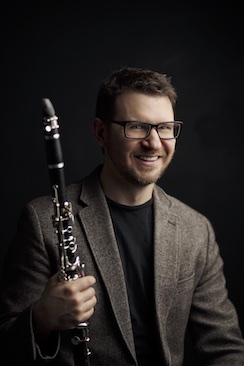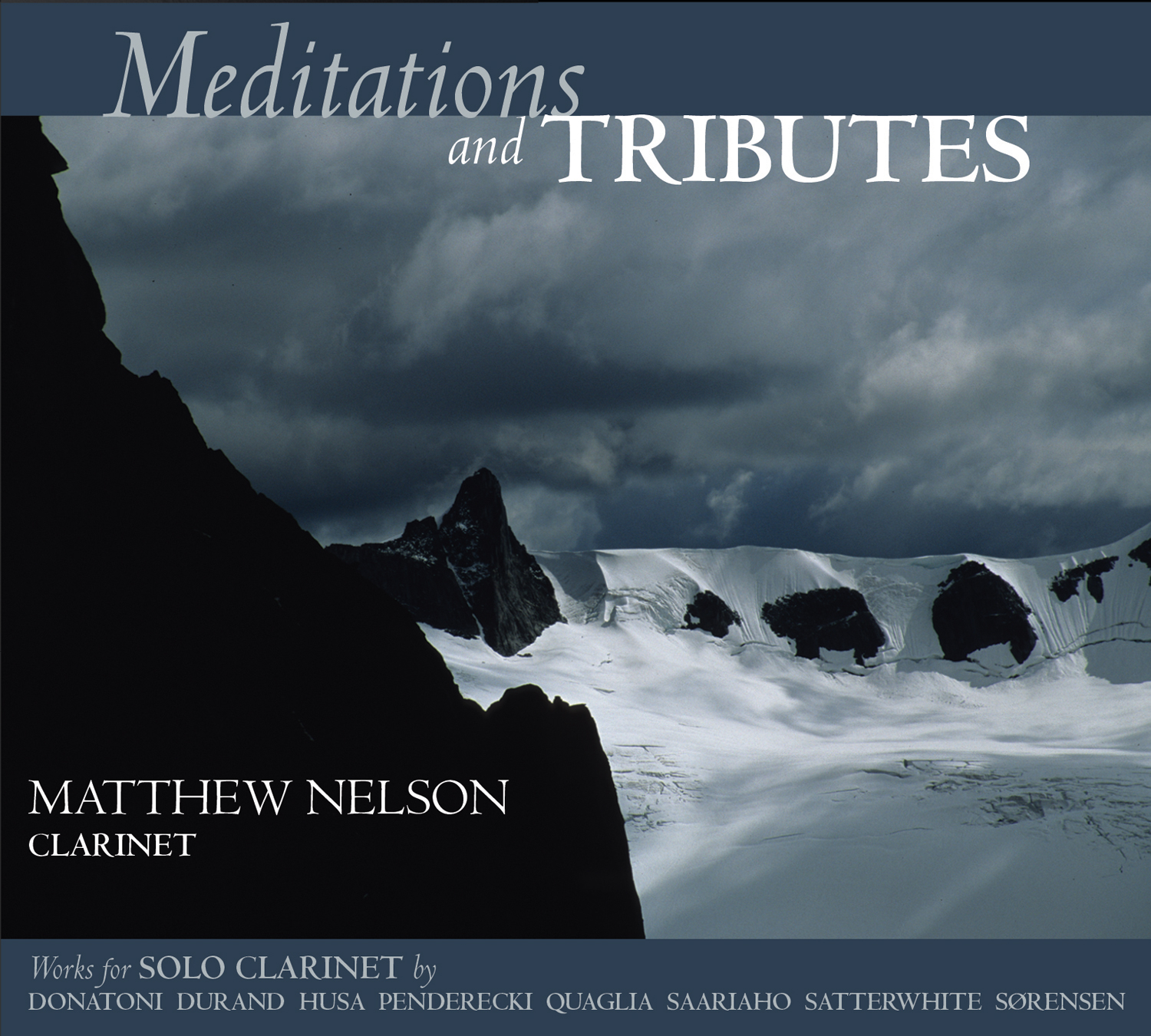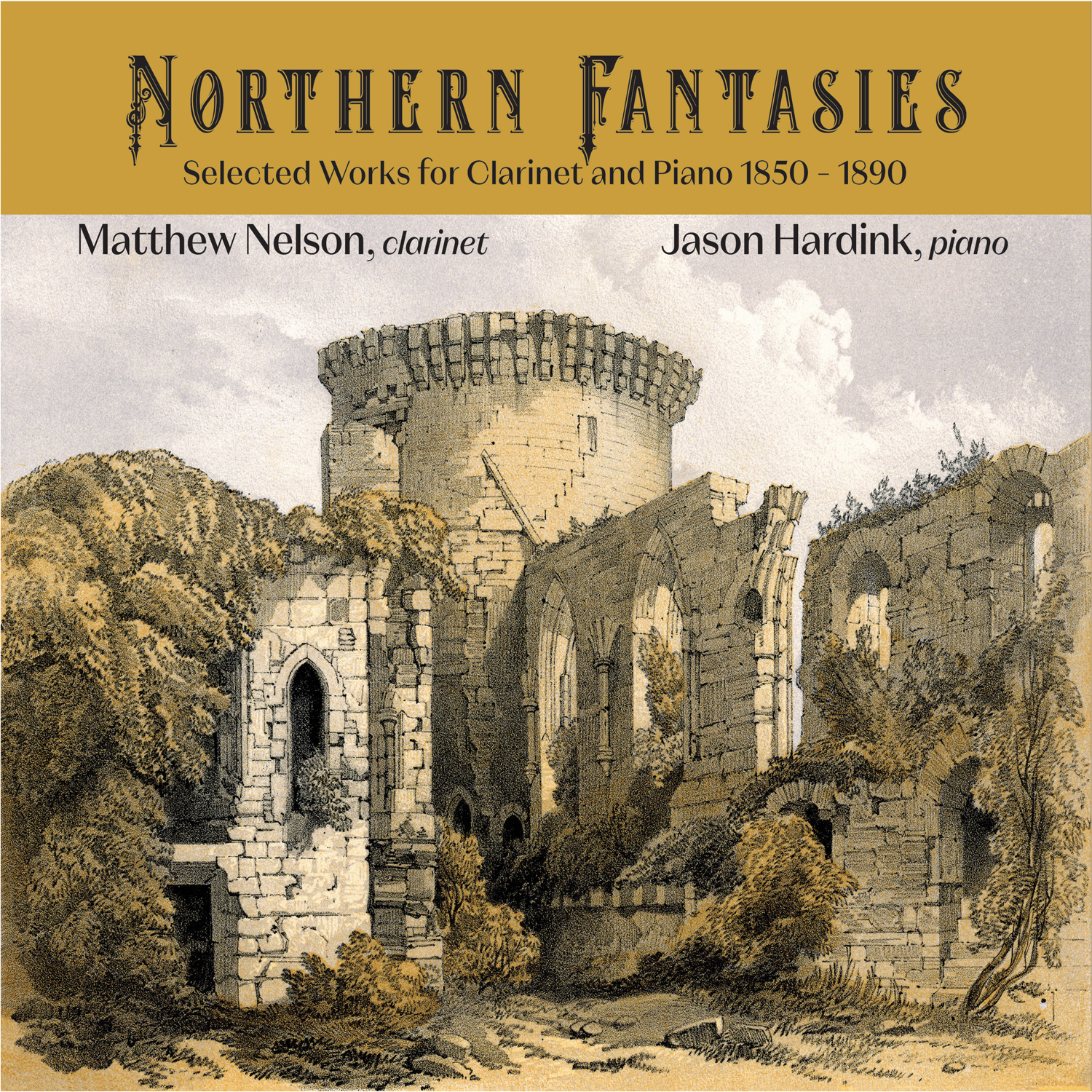
Fine Classical, Instrumental, and Specialty Recordings
Label: Soundset Recordings Item Number: SR1087 Format: CD Year Recorded: 2017 Meditations and Tributes: Works for Solo Clarinet Matthew Nelson
Matthew Nelson  Hailed for his "astounding range and virtuosity" (CD HotList), Matthew Nelson is Associate Professor of Clarinet at the University of Louisville, where he performs with the Louisville Winds woodwind quintet and the Grawemeyer Players contemporary music ensemble. He has performed as guest principal clarinet with the Virginia and Utah Symphonies, and his performances throughout the United States, Europe, and Asia include international competitions and premieres. He maintains an international profile as both performer and pedagogue, with engagements as invited professor on the faculties of the Beyond the Music International Chamber Music Festival, the Conservatorio Superior de Música de Castilla-La Mancha, and the Curso Internacional "Eduardo Ocón" in Spain. Nelson’s recent solo CD release, Meditations and Tributes, was lauded as "an unreserved success" (Fanfare), demonstrating a "staggering command of the instrument" (textura). Prior to his appointment at the UofL, Nelson held the position of principal clarinet with the Utah Chamber Orchestra (Ballet West). He served on the faculty of Utah Valley University for five years, where he was a founding member of the critically acclaimed Alpine Chamber Winds woodwind quintet. He was a NOVA Chamber Music Series artist from 2011 - 2014, and he also held an artist/faculty position at the Tuacahn Summer Symphonic Institute in St. George, UT. In 2013 he gave master classes and performed at the Instituto para el Desarrollo Musical in Castellón, Spain. Nelson’s frequent chamber music collaborations have reached enthusiastic audiences at the Schumann Festival, the Gentse Vleugels Festival, the Utah Music Festival, the Beethoven Festival Park City, and the Park City International Music Festival. He has also performed at the International Clarinet Association’s annual ClarinetFest in Knoxville, Ostend, Orlando, Lawrence, Baton Rouge, Assisi, Tokyo, and Washington, D.C. An advocate of new music, Nelson has worked closely with many prominent contemporary composers, including Kaija Saariaho, Shulamit Ran, Steve Rouse, Marc Satterwhite, William O. Smith, Agata Zubel, Joël-François Durand, Bruce Quaglia, Morris Rosenzweig, Diane Thome, Dan Welcher, and Eric Flesher. Nelson completed his doctoral work in clarinet performance at Rice University’s Shepherd School of Music in 2009 with his thesis, Morton Feldman’s Clarinet Works: A Study Through the Words of the Note Man. He received a MM in clarinet performance and a BA with distinction in English from the University of Washington. His principal teachers include Michael Webster, William McColl, Richard Gellman, and Scott Wright. Nelson is a Buffet Crampon Artist/Clinician and a D’Addario Woodwinds Artist. Duft - Kaija Saariaho Kaija Saariaho composed Duft in 2011 on a commission from the Ernst von Siemens Musikstiftung for the Internationaler Klarinettenwettbewerb Freiburg 2012. The German title "Duft" translates to "fragrance," and each of the movements relates to essential states of this overarching theme: I. Blütenstaub (Pollen), II. Blühend (In Bloom), and III. Flüchtig (Fleetingly). She has described Duft as an "intimate" work and an "expressive monologue." Saariaho creates novel tone colors with extended techniques in each of the three movements: Blütenstaub employs low percussive tremolos, flutters, multiphonics, wide vibrato, microtones, and glissandi, Blühend incorporates improvised grace notes through tremolos, and Flüchtig expands on those colors with increased range and dynamics in the wide vibrato, flutters, and extended glissandi. Nevertheless, she grounds the entire work in expressive melodic material, and the effects always serve the line. Matthew Nelson La mesure des choses: I. La mesure de l’air - Joël-François Durand La mesure des choses I. La mesure de l’air for solo clarinet belongs to a group of four pieces for solo instruments, to be played either in succession in the same concert, or separately. The other works are for piano solo, oboe and viola, and for percussion. The original conception for this set is based on Heraclitus cosmogony, which includes transformations of one element (air-sea-earth-fire, with the addition of time) into each other. My reflexion on these transformations led me to interpret these natural elements in their relation to human experience: in the case of this work, the air is a representation of the present, what goes continually through the human body, barely perceptible yet always in changing motion, like the immediate passage of time: it is the present in the human consciousness. In La mesure de l’air, a number of melodic models - archetypes - are constantly transformed, their rhythmic and intervallic contents being altered every time they come back. The texture of the piece is therefore often changing, but the main activity is one of a febrile, creative activity renewing itself unceasingly. La mesure de l’air was a commission of the Festival "Musica," Strasbourg, and was premiered at Musica by Armand Angster 18 September 1993. Joël-François Durand Tiodhlac - Joël-François Durand Tiodhlac is the Scottish Gaelic word for "gift." It was written as a tribute to James Dillon, for a concert commemorating his 50th birthday. It was premiered at the Warehouse, London, UK by Roger Heaton 4 October 2001. Joël-François Durand Clair - Franco Donatoni Franco Donatoni resolved to quit composing toward the end of the 1970s, finding himself unable to bear the act of notating his increasingly monstrous orchestral works. But an outstanding commission for the Accademia Musicale Chigiana prompted the reluctant composer to write Ash, a chamber work for eight players. The clarity and differentiation of the lines in Ash set him on a path toward recovery from his compositional impasse, though his fundamental approach to the transformative generation of material would not change. Donatoni composed Clair, a set of two pieces for clarinetist Giuseppe Garbarino, in 1980, as he was writing a number of other solo instrumental works in the years immediately following Ash. Clair’s two pieces typify Donatoni’s process of transitional figuration, with sectional "blocks" or "panels" of material varied by substitution/elimination/etc., yet unified by the searing intensity of his broadly projected thematic elements. Though both pieces in Clair share this approach, they diverge dramatically in character. The first piece inhabits a pervasively loud and figured sound space, replete with rapid wide intervals, fantastical leaps, flurries of mordents/inverted mordents, syncopations, and glissandi. Its range reaches the upper and lower limits of the clarinet, even venturing to the sounding low D-flat/C-sharp only accessible on a full Boehm system clarinet (relatively common in mid-20th Century Italy). In stark contrast, the second piece begins at the limit of audibility, cycling through tight rapid cells in the chalumeau. The very quiet dynamic is maintained throughout most of the piece, interrupted only occasionally by more aggressive outbursts. Matthew Nelson After Milton: Three Vignettes for B-flat Clarinet - Bruce Quaglia After Milton: Three Vignettes for B-flat Clarinet was composed for the Italian clarinetist Arianna Tieghi and is dedicated in Memoriam to American composer Milton Babbitt (1916 - 2011), a leading figure in post-war American music and a mentor to numerous generations of younger American composers. Babbitt’s solo clarinet work My Ends are My Beginnings provides some of the source material for the present work, but the Vignettes are neither a set of variations nor a re-composition of that earlier piece; instead they are a meditation upon the expansive world of possibilities that Babbitt’s music inhabited. Bruce Quaglia Songs of the Decaying Garden - Bent Sørensen Bent Sørensen originally composed Songs of the Decaying Garden in 1986 under the title Impromptu for the Lerchenborg Workshop. Initially a self-taught composer, he had begun formal studies with Nørholm in 1983, and, having completed his studies with Nørholm and Nørgård by 1990, Sørensen made substantial revisions to this clarinet work in 1992 in conjunction with clarinetist John Kruse’s premiere recording. It was at this point that he changed the title to its present form. Erik Jakobsen notes "Sørensen’s fascination with the disintegration and degeneration of the manifestations of life," from which the Songs of the Decaying Garden seems to take its inspiration. The work’s three movements reflect this sense of dissolution while maintaining impressive depth and lyricism. Sørensen employs subtle but nearly constant dynamic shifts alongside microtones, nested rhythms, rapid staccato notes, glissandi, and flutters, creating a layered sonic texture that recalls the soundscape of the New Complexity movement. Matthew Nelson For Dallas - Marc Satterwhite Dallas Tidwell was a longtime friend and colleague. He played clarinet for many years in the Louisville Orchestra and was the clarinet professor at the University of Louisville, where I have taught since 1994, for a long time as well. Besides music, we shared a passion for cooking, and we made meals for each other on many occasions. Dallas was a good friend to composers, commissioning, performing and recording a number of pieces, including several of mine, most notably Passagework, a cycle for voice, clarinet and piano which he performed with his wife, soprano Edith Davis Tidwell. Dallas died in May of 2015, at the age of 64, after a battle with cancer that lasted several years. His family, friends, colleagues, students, and admirers of his musicianship were deprived of his presence much too soon. This work explores the entire range of the clarinet, and also requires a huge dynamic range and the ability to negotiate sudden changes in mood. It aims to portray many of the emotions we experience in times of loss, from rage to resignation. It is part of a series of short pieces in recent years dedicated to the memories of several friends and colleagues as well as two of my former teachers. Some of them share the opening motive of this piece and the same flexible approach to rhythm. They all explore the wide pitch and dynamic ranges required by For Dallas, and the same kaleidoscopic mood shifts. Marc Satterwhite Three Studies for Solo Clarinet - Karel Husa Czech-American composer Karel Husa wrote Three Studies for Solo Clarinet for the 60th Prague Spring International Music Competition in 2008, dedicating the work to Professor Jirí Hlavác for his 60th birthday. Husa notes in the score that the "three contrasting and virtuoso parts - Mountain Bird, Poignant Song and Relentless Machine - progressively represent three different characteristics of playing: espressivo, legato and staccato." Mountain Bird initiates the piece with a ringing invocation, cycling through permutations of the opening motive as it variously rejoices, whispers, and cries. Poignant Song opens with notes sliding into and out of one another, establishing an exaggerated legato character that Husa continues to manipulate through dynamic and registral extremes. In Relentless Machine, Husa explores the intersection of tone color and articulation: he employs a variety of notational combinations for staccato attacks while also specifying that the performer use a breathy, natural, or reedy tone quality. Matthew Nelson Prelude - Krzysztof Penderecki Krzysztof Penderecki wrote his short Prelude for solo clarinet in 1987 as a gift for composer Paul Patterson’s 40th birthday. Prelude begins very slowly and softly with a recurrent low G, and through the first few minor 3rd and semitone gestures it generates what will become pervasive intervallic motives. On a very large scale, Penderecki projects a rough accelerando-ritardando mirror form that spans the entire piece. This symmetrical arc reaches its peak on a fortissimo B-flat at the top of the clarinet’s range, after which it gradually returns to the opening G, providing global cohesion to the minor third. Penderecki further highlights the work’s intervallic saturation with distinctive series of semitone-related minor 3rd tremolos. Matthew Nelson
Label: Soundset Recordings Item Number: SR1087 Format: CD Year Recorded: 2017 Recording Engineer: Adam Copelin This album features premiere recordings of pieces by Kaija Saariaho, Joël-François Durand, Bruce Quaglia, and Marc Satterwhite, and includes contemporary masterworks by Donatoni, Sørensen, Husa, and Penderecki. The works on this album were composed between 1980 and 2015, and each presents the listener with complex soundscapes that push the boundaries of clarinet technique. Matthew Nelson is a clarinetist of astounding range and virtuosity, with a tone that is never less than burnished and lovely no matter how spiky and challenging the music he may be playing. And on this album he plays plenty of spiky and challenging music (as well as plenty of humorous and even lyrical music). It’s a collection of late-20th- and early-21st-century works for unaccompanied clarinet, and as you might expect the styles and moods vary widely. Among the highlights are Franco Donatoni’s Clair suite, on which Nelson manages to sound as if he’s playing multiple instruments at once, and Krzysztof Penderecki’s Prelude. For all libraries supporting wind or contemporary-music programs. - Rick Anderson, CD HotList: New Releases for Libraries Wonderfully controlled playing a a real sense of resonance with the contemporary clarinet repertoire are the two major strands that conspire to make this disc an unreserved success. Not for the faint-hearted, perhaps, as a glance at the featured composers will confirm, but there is such rewarding listening on offer here. Written in 2011, Kaija Saariaho’s three movement Duft opens with barely audible low tremolo before exploring a variety of techniques including multiphonics, wide vibrato and microtones. Intrinsically lyrical and described by the composer herself as “intimate” and as an “expressive monolog,” the piece swoops, bends and explores the nature of near-silence fascinatingly. This appears to be the only commercially available recording of the work. The work Le Mesure des Choses (2001) by Joël-François Durand is split into four pieces, of which this, the first, is for solo clarinet (the others are for piano solo, oboe and viola, and percussion; III has been recorded by viola player Paul Silverthorne on Mode 139). The complete set examines in musical terms the four elements, plus time, and it starts with the work presented here, which focuses on air. A work of continual change of basic shapes within time, Durand’s very active work is given a phenomenal performance by Nelson, whose virtuosity seems custom built for this music. The rapid delivery acts, also, as an excellent foil to the lyricism of the Saariaho piece. The other Durand piece, Tiodhlac, takes its name from the Scottish Gaelic word for “gift” and was intended as a tribute to composer James Dillon, celebrating that composer’s fiftieth birthday. The ultra-sensitive playing by Nelson coupled with his extraordinary control of the clarinet’s very uppermost register gives the word a markedly haunting aspect. The name Franco Donatoni will need no introduction to listeners of contemporary music; every time I see his name or hear a composition by him, I am reminded that there is a severe paucity of recordings of his music, not to mention performances in the concert hall or recital room. Dating from 1980, Clair is one of his most popular pieces, with a remarkable three recordings available in addition to this one. The work’s two movements are contrasting, the first bursting with irrepressible, jumping energy, the second far more restrained, returning us to the emotional world of the opening of the Saariaho. The quiet, rapid figuration emerges as beautifully evocative in Nelson’s supremely musical account. Subtitled “Three Vignettes.” Bruce Quaglia’s After Milton is intended as an in memoriam for the great Milton Babbitt; to that end, Quaglia uses material from Babbitt’s My Ends are My Beginnings to create a quiet, profound set of meditations. This is an inventive piece shot through with meaning. According to arkivmusic.com, there is only one other piece by Quaglia in the catalog, a Quartet for flute, clarinet, violin and cello on the Centaur label (a disc entitled New Music from Utah). An Associate Professor of Music Theory at the University of Utah’s School of Music, Quaglia clearly composes systematically: this piece is tightly organized and, although the musical surface is different, there is a sense of Webernian clarity. Again, this appears to be the only recording available of Bent Sørensen’s evocatively titled Songs of the Decaying Garden. Originally titled Impromptu when it first appeared in 1986, the piece was revised in 1992 when John Kruse recorded it (for Paula records, entitled Contemporary Danish Works for Clarinet where it shared disc space with Koppel, Bentzon and Ruders; this disc appears to be no longer available). The Songs of the Decaying Garden concentrates on the process of dissolution, giving three “viewpoints” indicated via the movement indications: Andantino, con delicatezza; Allegretto maniac; Calmo, molto dolce. There is a melting, internal aspect to the work’s final panel that is simply lovely; Nelson’s legato is beyond reproach here. Works by Marc Satterwhite (born 1954) have so far appeared on the Centaur label, so it is good to widen the envelope and find the 2013 piece For Dallas here on Soundset. The work refers to a person, Dallas Tidwell, rather than the place. Tidwell was a clarinetist in the Louisville Orchestra, a Professor of Clarinet at the University of Louisville and was a colleague of Sattershite’s. Tidwell sadly passed in 2015 after a battle with cancer. Satterwhite presents an exploration of the varied emotions of loss couched in a restlessly shifting musical environment. The effect is disturbing, perhaps because it confronts us, ultimately, with our own sense of mortality, of our own lives being of finite duration. A disc of music by Czech-American composer Karel Husa on Albany, which included the powerful Music for Prague 1968, impressed me, and the piece here, Three Studies (2007), is another fine example of Husa’s output. Each movement presents a different trait of clarinet playing: espressivo (“Mountain Bird”), legato (“Poignant Song”) and staccato (“Relentless Machine”). The final movement is especially interesting in its notation, specifying a variety of staccato articulation in combination with specific tone qualities, all performed with admirable confidence by Nelson. Finally, a piece by the most familiar name on the roster of composers here, Krzysztof Penderecki. The short Prelude of 1987 operates like a sonic arch, moving towards a glaring climax high up in the clarinet’s range before returning to the quiet of the opening. Nelson’s minor third tremolos are perfectly judged, as is his tracing of the work’s trajectory overall. Recording quality is of the very top drawer, with the ultra-quiet dynamics just caught perfectly and with just the right amount of space to the sound picture. - Colin Clarke, Not To Be Missed | 
Physical CD $16.99 US
| ||||||||||||||||||||||||||||||||||||||||||||||||||||||||||||||||||||||||||||||||||||||||||||||||||||||||||||||||||
 Amazon
Amazon
 Follow Us on Twitter
Follow Us on Twitter Follow Us on Instagram
Follow Us on Instagram Visit Our Partner Soundset Recordings
Visit Our Partner Soundset Recordings